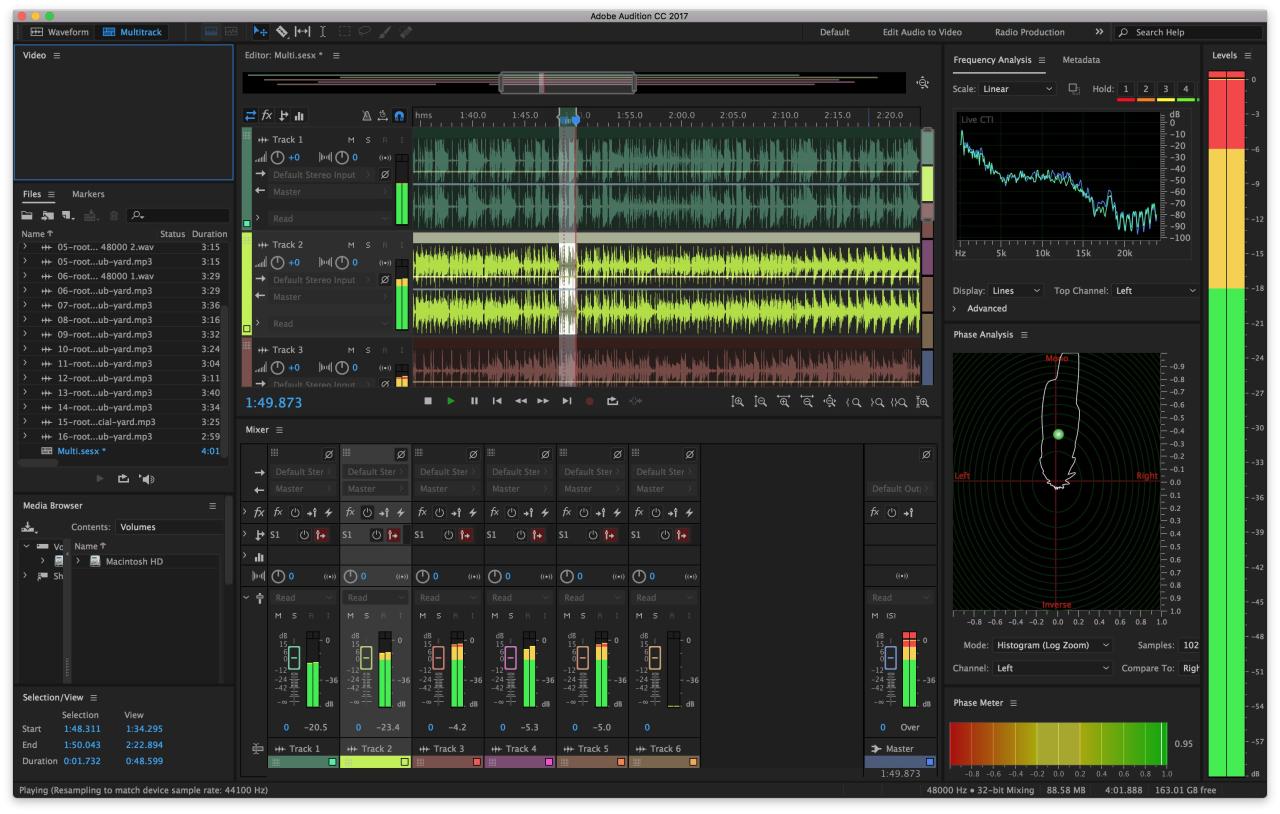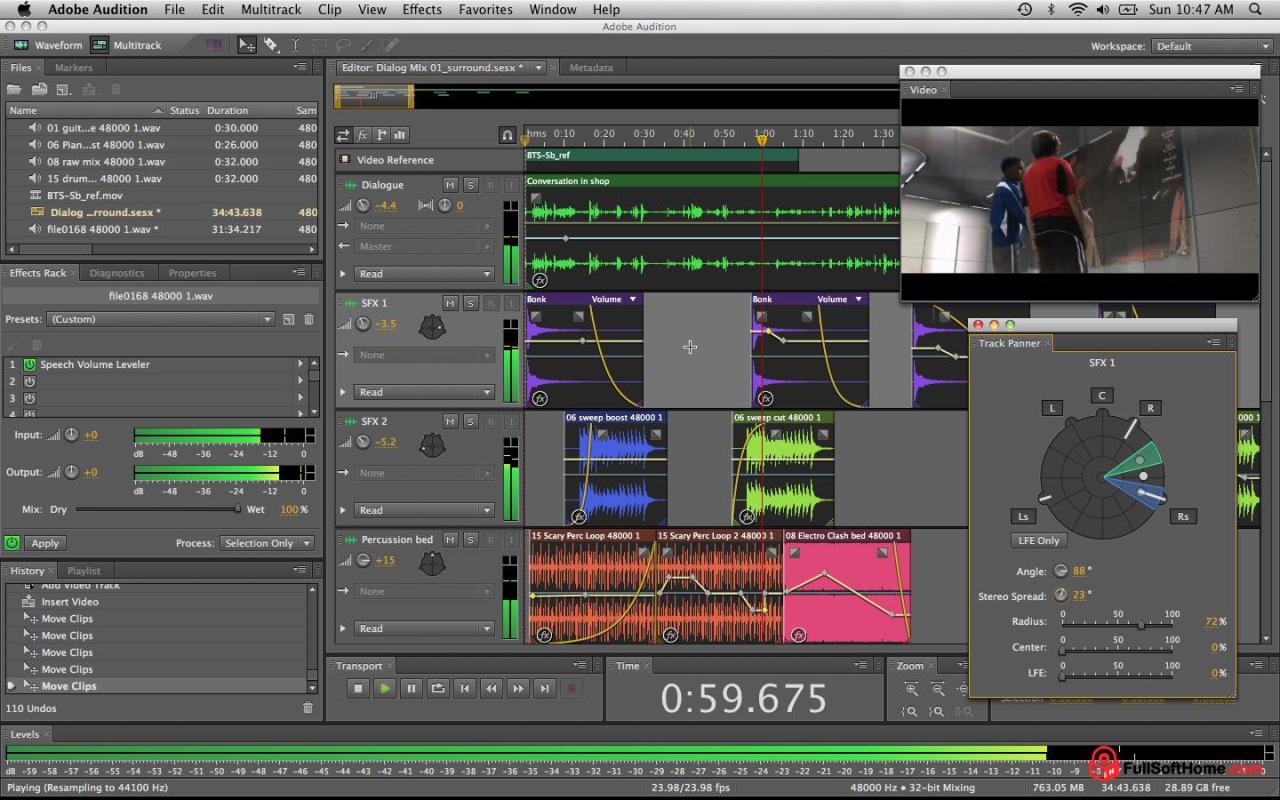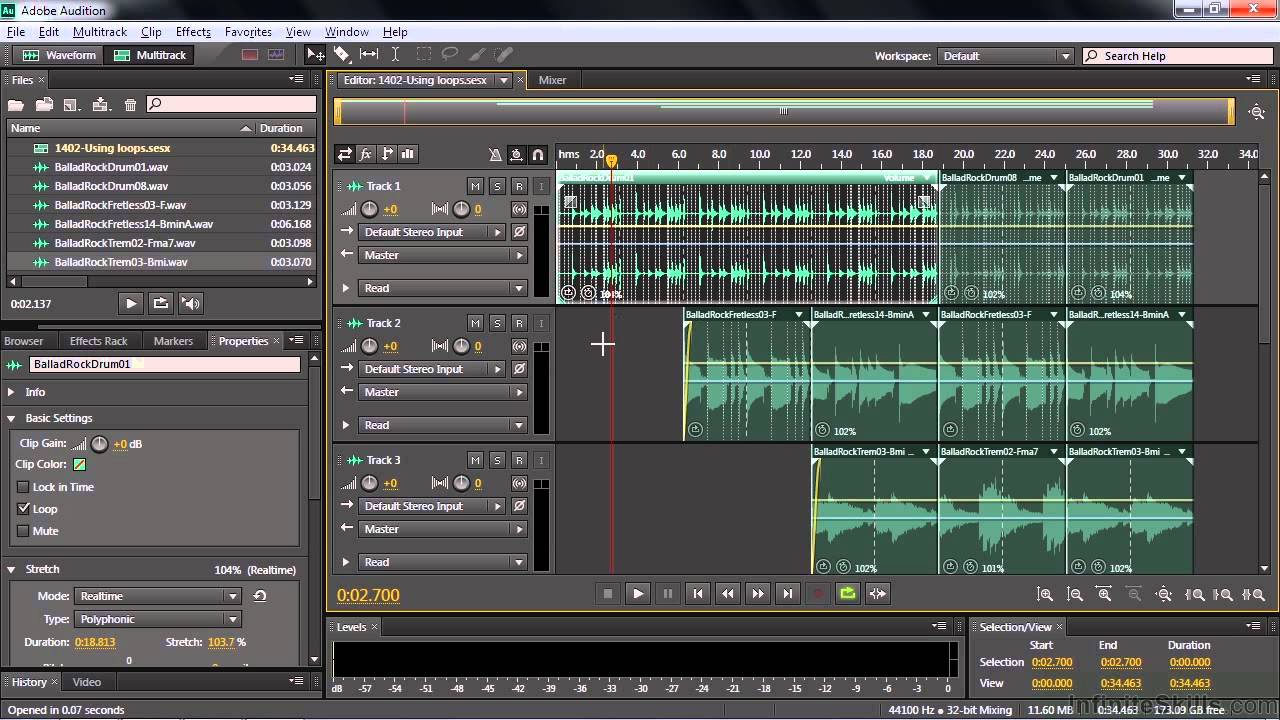Adobe Audition, a powerful audio workstation, empowers creators across industries to craft exceptional audio experiences. From musicians and podcasters to film editors and sound designers, Adobe Audition provides an array of tools and features to elevate audio quality, enhance creative expression, and streamline workflows.
Table of Contents
Adobe Audition’s roots trace back to Cool Edit Pro, a popular audio editor acquired by Adobe in 2003. Since then, it has evolved into a comprehensive audio production suite, boasting a user-friendly interface, advanced audio editing capabilities, and seamless integration with other Adobe Creative Cloud applications.
Introduction to Adobe Audition

Adobe Audition is a powerful audio editing and mixing software designed for professionals and enthusiasts alike. It offers a comprehensive suite of tools for recording, editing, mixing, mastering, and restoring audio. Whether you’re a musician, podcast producer, sound designer, or video editor, Adobe Audition can help you create high-quality audio content.
Target Audience
Adobe Audition caters to a wide range of users, including:
- Musicians and Composers: Audition provides tools for recording, editing, and mixing music, including multi-track recording, virtual instruments, and effects processing.
- Podcasters and Voiceover Artists: Audition offers features for recording, editing, and mastering voiceovers, including noise reduction, equalization, and compression.
- Sound Designers and Audio Engineers: Audition is equipped with advanced tools for sound design, including sample editing, synthesis, and sound effects creation.
- Video Editors: Audition can be used for audio editing in video projects, including dialogue cleaning, sound effects, and music mixing.
History and Evolution
Adobe Audition has a long history, evolving from its original name “Cool Edit Pro” in 1999.
- Cool Edit Pro (1999): The initial version focused on multi-track recording and editing, offering basic features for audio manipulation.
- Adobe Audition 1.0 (2003): Adobe acquired Cool Edit Pro and rebranded it as Adobe Audition. This version introduced advanced features like spectral editing and noise reduction.
- Adobe Audition CS (2005): With the Creative Suite integration, Audition gained new capabilities for audio restoration, mixing, and mastering.
- Adobe Audition CC (2013): The transition to the Creative Cloud brought regular updates and subscription-based access, enhancing features like collaborative workflows and cloud storage.
- Adobe Audition (2020): The latest version features improvements in performance, user interface, and functionality, including enhanced spectral editing, immersive audio support, and AI-powered tools.
Audio Editing Techniques

Audio editing involves manipulating audio recordings to enhance their quality, clarity, and overall impact. Adobe Audition offers a wide range of tools and features that empower you to refine your audio content, from basic adjustments to advanced manipulations.
Basic Editing Tools
Basic editing tools are the foundation of audio manipulation, enabling you to refine the structure and organization of your audio clips.
- Trimming: This technique involves removing unwanted portions of an audio clip, such as silence at the beginning or end, or removing sections that contain errors or distractions.
- Splitting: Splitting divides a single audio clip into multiple segments, allowing for individual editing of specific sections. This is useful for isolating parts of a recording for further processing or rearranging.
- Merging: Merging combines multiple audio clips into a single, continuous track. This enables you to seamlessly join different recordings or create a unified audio sequence.
Noise Reduction
Noise reduction techniques aim to minimize unwanted background noise from audio recordings, improving the overall clarity and intelligibility.
- Spectral Noise Reduction: This method analyzes the frequency spectrum of the noise and selectively reduces its presence in the audio signal. This is effective for reducing consistent background noise, such as hum or hiss.
- Adaptive Noise Reduction: This technique adapts to the characteristics of the noise, adjusting the reduction level based on the specific noise pattern. This approach is particularly effective for dealing with fluctuating or complex noise sources.
Equalization
Equalization (EQ) involves adjusting the frequency balance of audio signals to enhance specific frequencies or reduce unwanted ones.
- High-Pass Filter: This filter removes low-frequency content, such as rumble or unwanted bass frequencies, improving the clarity of the audio signal.
- Low-Pass Filter: This filter removes high-frequency content, such as sibilance or harshness, smoothing out the audio signal.
- Band-Pass Filter: This filter allows a specific range of frequencies to pass through, enhancing or isolating specific elements of the audio signal.
- Parametric Equalizer: This type of EQ allows for precise adjustments to specific frequencies, enabling you to shape the audio signal to your liking.
Compression
Compression involves reducing the dynamic range of an audio signal, making quiet parts louder and loud parts softer.
- Dynamic Range: The difference between the loudest and quietest parts of an audio signal.
- Compression Ratio: The ratio of the amount of signal reduction to the amount of signal increase. For example, a 4:1 ratio means that for every 4 dB of signal increase, the compressor reduces the signal by 1 dB.
- Threshold: The level at which the compressor starts to reduce the signal.
- Attack Time: The time it takes for the compressor to start reducing the signal after it crosses the threshold.
- Release Time: The time it takes for the compressor to stop reducing the signal after it falls below the threshold.
Audio Effects and Plugins
Adobe Audition offers a wide range of built-in audio effects that can be used to enhance, manipulate, and repair audio. These effects are categorized into different groups, each offering unique functionalities. Additionally, the software allows you to expand its capabilities by incorporating third-party plugins, which provide even more diverse options for audio processing.
Types of Audio Effects
The built-in effects in Adobe Audition are categorized into various groups, each designed to address specific audio processing needs. Here are some of the major categories:
- Amplitude Effects: These effects manipulate the overall volume or loudness of the audio signal. They include:
- Gain: This effect allows you to increase or decrease the overall volume of the audio.
- Compressor: This effect reduces the dynamic range of the audio, making quieter parts louder and louder parts quieter.
- Limiter: This effect prevents the audio signal from exceeding a certain volume threshold, ensuring that the audio doesn’t clip or distort.
- Time Effects: These effects manipulate the time dimension of the audio, including:
- Delay: This effect creates echoes or repetitions of the original audio signal.
- Reverb: This effect simulates the sound of a room or space by adding reflections and echoes.
- Pitch Shift: This effect changes the pitch of the audio without affecting its tempo.
- Frequency Effects: These effects manipulate the frequency content of the audio signal, including:
- Equalizer: This effect allows you to boost or cut specific frequencies in the audio.
- High-Pass Filter: This effect removes low-frequency content from the audio, often used to remove rumble or unwanted bass.
- Low-Pass Filter: This effect removes high-frequency content from the audio, often used to create a warmer or smoother sound.
- Special Effects: This category includes a variety of effects that add unique characteristics to the audio, such as:
- Distortion: This effect adds a gritty or fuzzy sound to the audio, often used to create a heavier or more aggressive sound.
- Chorus: This effect creates a thicker, richer sound by adding multiple copies of the original audio signal with slight variations in pitch and delay.
- Flanger: This effect creates a swirling, jet-like sound by adding copies of the audio signal with varying delays and frequencies.
Using Third-Party Plugins, Adobe audition
Adobe Audition allows you to install and use third-party plugins to expand its capabilities. These plugins are developed by independent companies and often offer specialized features or effects that are not included in the standard Adobe Audition software.
- Installation: Most third-party plugins can be installed by placing them in the designated plugin folder within the Adobe Audition installation directory.
- Integration: Once installed, third-party plugins appear in the Effects Rack within Adobe Audition, allowing you to easily access and use them.
- Examples: Popular third-party plugin developers include iZotope, Waves, and FabFilter. These companies offer a wide range of plugins for various audio processing needs, including mastering, equalization, and creative effects.
Examples of Audio Enhancement
Audio effects can be used to enhance audio in numerous ways, depending on the specific requirements of the project. Here are some examples:
- Noise Reduction: Using a noise reduction effect, you can remove unwanted background noise from recordings, such as hum, hiss, or wind noise.
- Equalization: By adjusting the frequency content of the audio, you can improve the overall clarity and balance of the sound. For example, boosting the high frequencies can make vocals sound more crisp and detailed, while cutting the low frequencies can reduce muddiness.
- Reverb: Adding reverb can create a sense of space and depth to the audio, making it sound more natural or immersive.
- Delay: Delay can be used to add a sense of movement or rhythm to the audio, often used in music production to create a more layered or interesting sound.
Workflow and Automation
Adobe Audition offers a comprehensive suite of tools that can be used to streamline your audio editing workflow and automate repetitive tasks. By understanding and implementing efficient workflows, you can significantly enhance your productivity and achieve professional-quality audio results.
Workflow for Different Audio Projects
A typical workflow in Adobe Audition can vary depending on the specific project, but generally involves several common steps. Here is a general overview:
- Import and Organize Audio Files: Begin by importing your audio files into Audition. Use the “Import” function or drag and drop files into the workspace. Organize your files into folders and tracks for easy access and management.
- Editing and Cleaning: Clean up your audio by removing unwanted noise, pops, clicks, or other artifacts. Utilize tools like the “Noise Reduction” effect, “Click and Crackle Removal” effect, and “Equalizer” to enhance audio quality.
- Mixing and Mastering: Mix and master your audio by adjusting levels, panning, equalization, and other parameters. Use Audition’s powerful multitrack mixing environment and various effects to create a balanced and polished sound.
- Exporting and Delivering: Once your audio is finalized, export it in the desired format, such as WAV, MP3, or AIFF. Choose appropriate settings for bitrate, sample rate, and other parameters based on your project’s requirements.
Automating Repetitive Tasks
Adobe Audition provides powerful features for automating repetitive tasks, saving you time and effort. You can leverage macros and scripts to automate actions like:
- Creating Custom Effects: Combine multiple effects into a single macro for easy application to different audio clips.
- Batch Processing: Automate the application of effects or adjustments to multiple audio files simultaneously.
- Renaming Files: Use macros to rename multiple files based on specific criteria, such as adding prefixes, suffixes, or changing file extensions.
- Exporting Files: Create macros to automate the export process, including setting output formats, file names, and other parameters.
Optimizing Workflow Efficiency
To maximize your workflow efficiency in Adobe Audition, consider these tips:
- Use Keyboard Shortcuts: Learn and utilize keyboard shortcuts for frequently used actions, reducing mouse clicks and saving time.
- Customize Workspaces: Configure your workspace to suit your specific needs by adding or removing panels, customizing toolbars, and setting preferences.
- Utilize Markers and Regions: Mark specific points in your audio for easy navigation and referencing, and create regions to isolate sections for editing.
- Employ Multitrack Editing: Utilize Audition’s multitrack environment to edit multiple audio tracks simultaneously, streamlining your workflow and enhancing organization.
“Efficiency is doing things right; effectiveness is doing the right things.” – Peter Drucker
Industry Applications
Adobe Audition is a powerful audio editing software that finds widespread application across numerous industries. Its versatility and comprehensive feature set cater to the diverse needs of professionals working in music production, film and television, podcasting, and radio broadcasting.
Music Production
Music producers rely heavily on Adobe Audition for various tasks, including:
- Recording and Editing: Audition’s multitrack recording capabilities allow producers to capture and edit audio from multiple sources simultaneously, facilitating the creation of complex musical arrangements.
- Mixing and Mastering: The software’s extensive suite of audio effects and plugins enables producers to achieve professional-quality mixes and masters. This includes tools for equalization, compression, reverb, and delay, among others.
- Sound Design: Audition’s sound design tools allow producers to create and manipulate sounds for use in their music, including synthesizers, drum samples, and other sound effects.
Film and Television
In film and television production, Adobe Audition is used for:
- Dialogue Editing: Audition’s advanced dialogue editing tools help to clean up audio recordings, remove unwanted noise, and synchronize dialogue with video footage.
- Sound Effects: The software is used to create, edit, and mix sound effects for films and television shows, adding realism and enhancing the overall audio experience.
- Music Scoring: Audition can be used to edit and mix music scores for films and television shows, ensuring that the music complements the visuals and enhances the emotional impact.
Podcasting
Podcasting is a rapidly growing medium, and Adobe Audition plays a vital role in the production of high-quality podcasts:
- Recording and Editing: Audition’s multitrack recording capabilities enable podcasters to record multiple audio sources, such as interviews, narration, and music, and edit them together seamlessly.
- Audio Enhancement: The software’s noise reduction and equalization tools help to improve the clarity and quality of podcast audio recordings, making them more enjoyable for listeners.
- Podcast Production: Audition’s tools for adding music, sound effects, and other audio elements facilitate the creation of engaging and professional-sounding podcasts.
Radio Broadcasting
Radio broadcasters use Adobe Audition for:
- Live Recording and Editing: Audition’s real-time recording and editing capabilities allow broadcasters to capture and edit live audio, such as news reports, interviews, and music.
- Audio Production: The software’s tools for adding music, sound effects, and other audio elements enable broadcasters to create engaging and dynamic radio programs.
- Audio Automation: Audition’s automation features can be used to schedule and play audio content, ensuring that radio programs run smoothly and efficiently.
Resources and Learning Materials: Adobe Audition
Adobe Audition offers a wealth of resources and learning materials to help you master the software and enhance your audio editing skills. From official documentation to online communities, there are numerous avenues for acquiring knowledge and support.
Official Adobe Audition Documentation
Adobe provides comprehensive documentation for Audition, covering all aspects of the software, from basic features to advanced techniques. The documentation is a valuable resource for users of all levels, offering detailed explanations, step-by-step instructions, and practical examples.
- The Adobe Audition User Guide is available online and can be accessed through the Adobe Help website. It provides a comprehensive overview of the software’s features and functionality, including detailed instructions on how to perform various tasks.
- Adobe also offers a series of tutorials and video guides on its website, covering various aspects of Audition. These tutorials are designed to help users learn specific skills and techniques, from basic audio editing to advanced audio mixing and mastering.
- Adobe regularly updates its documentation and tutorials to reflect the latest features and improvements in Audition. Users can access the latest version of the documentation and tutorials through the Adobe Help website.
Online Communities and Forums
Engaging with the online community is a great way to connect with other Adobe Audition users, seek help, and share knowledge. Online forums and communities provide a platform for users to ask questions, discuss challenges, and learn from the experiences of others.
- The Adobe Audition forum on the Adobe Community website is a popular destination for users to seek help, share tips, and discuss various aspects of the software.
- Other online forums and communities, such as Reddit’s r/audioengineering and Gearslutz, also offer discussions related to audio editing and Adobe Audition. These forums provide a valuable platform for users to connect with experienced audio engineers and other professionals in the field.
- Joining online communities and forums can help you stay up-to-date on the latest trends and developments in audio editing and Adobe Audition. Engaging with other users can also provide valuable insights and perspectives on various techniques and workflows.
Books and Other Learning Materials
There are several books and other learning materials available that can help you learn Adobe Audition and improve your audio editing skills. These resources provide in-depth explanations, practical exercises, and real-world examples to enhance your understanding of the software and its capabilities.
- Many books are available that cover the basics of audio editing, including topics such as recording, editing, mixing, and mastering. These books often provide a comprehensive overview of the software’s features and functionality, along with practical examples and exercises to help you apply your knowledge.
- There are also books that focus on specific aspects of audio editing, such as audio restoration, sound design, and music production. These books provide more in-depth coverage of specific techniques and workflows, helping you develop expertise in specific areas of audio editing.
- Online courses and video tutorials are also available, providing a flexible and interactive way to learn Adobe Audition. These resources often cover a wide range of topics, from basic audio editing to advanced techniques, providing a comprehensive learning experience.
Closing Summary

Whether you’re a seasoned professional or a budding audio enthusiast, Adobe Audition offers an empowering platform to explore the intricacies of audio production. With its versatile tools, comprehensive features, and a thriving community of users, Adobe Audition remains an indispensable tool for anyone seeking to create, edit, and master high-quality audio content.
